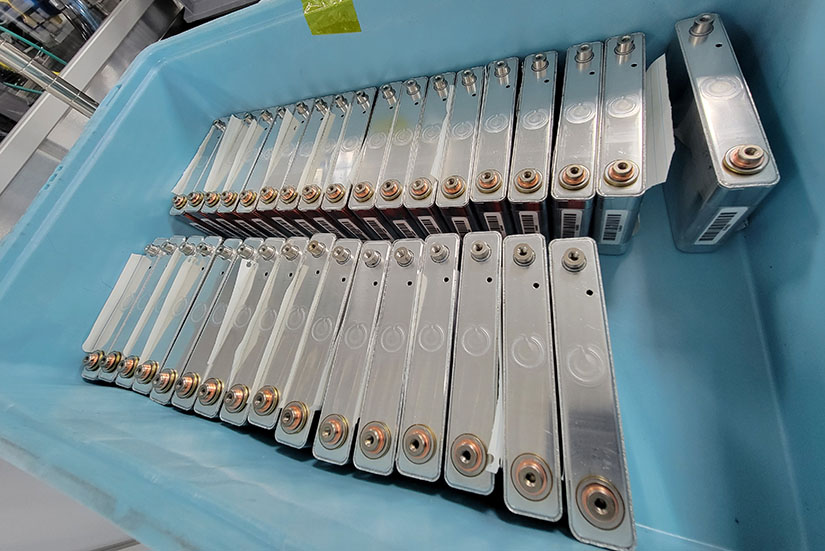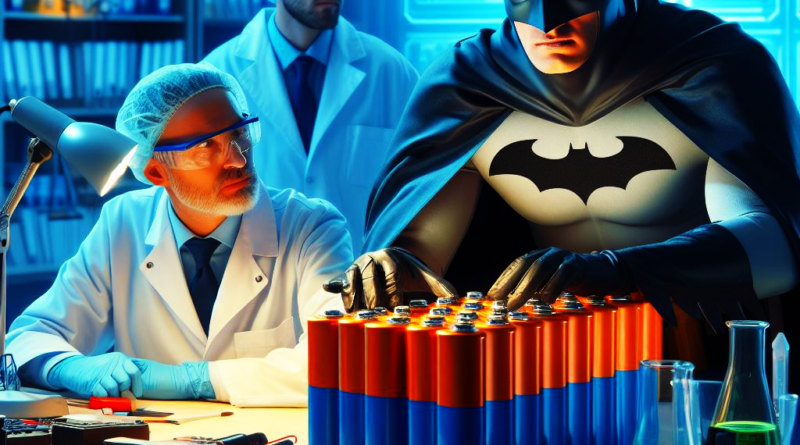Unleashing the Power: BatMan Project Revolutionizes Battery Manufacturing
Gotham City’s Dark Knight boasts an impressive collection of technological marvels, but the superhero scientists at the U.S. Department of Energy’s (DOE’s) National Renewable Energy Laboratory (NREL) have cutting-edge capabilities of their own.

A recent battery manufacturing project—affectionately called BatMan—has developed a novel laser patterning process to alter the microstructure of battery electrode materials. Funded by DOE’s Advanced Materials and Manufacturing Technologies Office, this project brings together expert minds from NREL, Clarios, Amplitude Laser Group, and Liminal Insights. This revolutionized manufacturing process could unlock significant improvements to electrified transportation, leading the charge toward a brighter and more sustainable future.
“BatMan builds on NREL’s expertise using laser ablation, advanced computational models, and materials characterization to address key challenges in battery manufacturing,” said Bertrand Tremolet de Villers, project co-lead and senior scientist in NREL’s Thin Film and Manufacturing Sciences group. “This new, high-throughput laser patterning process—demonstrated at scale with state-of-the-art roll-to-roll manufacturing techniques—uses laser pulses to quickly and precisely modify and optimize electrode structures, offering a massive leap in battery capabilities with minimal added manufacturing cost.”
Structural Challenges Signal Need for Innovation
Electric vehicles (EVs) have been identified as the single most important technology for decarbonizing the transportation sector, according to the International Council on Clean Transportation. However, estimates project that sales of EVs will need to reach up to 35% of the global market in 2030 to achieve net-zero greenhouse gas emissions by 2050. In addition, the U.S. National Blueprint for Transportation Decarbonization cites EVs powered by clean electricity as a critical component of our nationwide strategy. Continued advancements in battery technologies can improve energy efficiency and accelerate customer adoption by enabling EVs to charge faster and drive further.
The secret to optimizing battery performance lies in the electrodes, positively and negatively charged conductors that generate an electrical current through the movement of ions. The material makeup, thickness, and structural design of electrodes can impact battery capacity, voltage, and charging speed. For example, doubling the thickness of electrodes from 50 μm to 100 μm increases the energy density of a battery cell by about 16%. However, this increased thickness makes it notably more difficult to charge the battery quickly without causing long-term damage from lithium plating, which reduces the battery lifetime.

Thicker battery electrodes also introduce new concerns for battery manufacturers. After assembling battery cells, manufacturers begin the wetting process by injecting a liquid electrolyte into the cell to facilitate the flow of ions between electrodes. Imagine the electrode as a dry sponge; during wetting, the liquid electrolyte must spread and absorb evenly into the solid surface. Inadequate wetting can impede ion transport, resulting in slower charging and discharging rates, lower energy density, and decreased battery efficiency. However, wetting is costly and time consuming, and the larger surface area of thicker electrodes could increase the complexity of this process.
The EV industry needs a breakthrough battery design that combines the benefits of thicker electrodes and extreme-fast charging, without increasing manufacturing costs. The BatMan research team is answering the call with a process that optimizes electrode structures and streamlines battery production.
Identifying New Pore Patterns With State-of-the-Art Modeling
Prior NREL research illuminated how intricate patterns of tiny holes in an electrode—known as the pore network—can unlock battery improvements. These microscopic pores create access points to increase ionic diffusion, allowing the ions to move more quickly during charge and discharge without damaging the battery. As a manufacturing bonus, these pores also speed up electrolyte saturation during the wetting process.
“Early conversations between NREL’s battery researchers and material scientists uncovered an opportunity to utilize laser ablation to configure these pore networks,” said Donal Finegan, project co-lead and senior scientist in NREL’s Energy Storage group. “With support from our industry partners, BatMan established a new process to incorporate this technique into battery manufacturing. But first, we needed to know which pore patterns would yield the greatest battery benefits.”

To evaluate different pore channel shapes, depth, and distribution, researchers turned to NREL’s Lithium-Ion Battery Secondary Pore Network Design Optimization Analytical Diffusion Model. The BatMan team’s genetic algorithm also considered the specific hardware limitations of the laser used to create the pores. These advanced models—led by NREL researchers Francois Usseglio-Viretta and Peter Weddle—helped identify the optimal pore arrangement: a hexagonal pattern of laser-ablated pores with a depth of 50% of the electrode coating thickness. The study also found that adding straight channels across the width of the electrode dramatically improved electrode wetting when compared to unstructured electrodes.
“NREL’s electrochemical models were the foundation of our success,” Tremolet de Villers said. “Collaboration and continuous feedback between BatMan’s modeling and characterization researchers allowed our team to eliminate time- and cost-intensive trial and error to focus attention on pore channel geometries that would best achieve our goals.”
NREL’s Laser-Focused Approach To Optimize Electrodes
With a target pore network identified, the BatMan team began working toward small-scale prototyping and characterization of the laser-patterned electrode. Researchers used an Amplitude Laser Group femtosecond laser system with high-speed galvanometer-controlled scanning optics for the laser ablation, working closely with the Amplitude team to achieve precise control of the laser based on position, power, frequency, and number of pulses. NREL researchers Ryan Tancin and Dana Sulas-Kern led this process.

“Our collaboration with NREL helped integrate the laser into their existing research capabilities to support the BatMan project goals,” said Quentin Mocaer, line manager at Amplitude Laser Group. “We also received valuable insights into how future system designs and new technologies could further improve this process at an industrial scale.”
NREL researchers applied a variety of advanced characterization tools to evaluate the performance of the laser-ablated electrodes. First, researchers applied X-ray nano-computed tomography and scanning electron microscopy to analyze the morphological features of the electrode structure and validate battery enhancements. Next, NREL’s multiphysics models illustrated how improved uniformity in the structures reduced the risk of lithium plating during fast charging. Finally, the BatMan team assembled small battery cells to assess the optimized electrode architectures in action. Electrochemical analysis of the laser-ablated cells, led by NREL researcher Nathan Dunlap, demonstrated superior fast-charge performance, with nearly 100% more capacity after 800 cycles.

Revolutionizing Roll-to-Roll Manufacturing
After numerous cycles of laser ablation, characterization, and adjustment, it was time to scale up the process for high-throughput demonstration. Most battery manufacturing facilities use a continuous roller-based processing line, known as a roll-to-roll line, that bonds the active material mixture onto a foil surface. Researchers used NREL’s roll-to-roll line to demonstrate and de-risk the compatibility of this new process to encourage adoption by battery manufacturers.
“After nearly three years of research, our team successfully processed 700 meters of double-sided electrode material, proving that laser ablation is a scalable and economically feasible technique for roll-to-roll production of lithium-ion batteries,” Finegan said. “The magnitude of this demonstration was unique to NREL and showcases how strategic laboratory support can advance industry processes.”
NREL returned the optimized electrode material to BatMan’s manufacturing partner Clarios, where experts assembled commercially relevant 27-Ah batteries for further evaluation. Early inspection using Liminal Insights’ EchoStat acoustic imaging indicates that the laser-ablated electrodes wet faster and more uniformly than baseline cells. Additional nondestructive diagnostics will validate the expected performance improvements and ensure battery safety and quality before this technology enters the marketplace.

Improving Battery Performance for a More Sustainable Future
Time will tell how long it will take before laser-ablated cells find their way into electric vehicles, but the NREL team is optimistic. Techno-economic analysis of the laser patterning process estimates a minimal added cost to battery manufacturing of under $1.50/kWh—that is less than 2%—and the performance advantages are undeniable. NREL researchers also found that the graphite debris collected during the laser ablation process can be directly reused to make new battery cells without any significant impact to the cells’ performance, which presents an opportunity to further reduce the cost of laser ablating electrodes.
“Our lab-scale experimentation shows that laser-ablated electrodes could double the rate of charge of electric vehicles,” Finegan said. “This is a technology evolution that could alter conventional manufacturing, not only for lithium-ion batteries but also next-generation battery chemistries.”

As any good superhero knows, the fight for a better world is never finished. The approach used in the BatMan project could help identify, implement, and validate microstructure enhancements for any battery chemistry in the foreseeable future, including silicon, sulfur, and solid-state batteries. NREL experts believe laser ablation may be able to relieve mechanical strain, accommodate expansion during chemical changes, extend the cycle-life of batteries, and accelerate the manufacturing process by reducing filling and soaking times for various energy materials.
Whatever challenges tomorrow brings, NREL experts will be here, watching and waiting to offer leading research, energy expertise, and technological breakthroughs to support the clean energy transition.
Learn more about NREL’s manufacturing and sustainable transportation and mobility research. And sign up for NREL’s quarterly transportation and mobility research newsletter, Sustainable Mobility Matters, to stay current on the latest news.
By Rebecca Martineau, Courtesy of U.S. Department of Energy, NREL
Have a tip for CleanTechnica? Want to advertise? Want to suggest a guest for our CleanTech Talk podcast? Contact us here.
Latest CleanTechnica.TV Video

CleanTechnica uses affiliate links. See our policy here.

